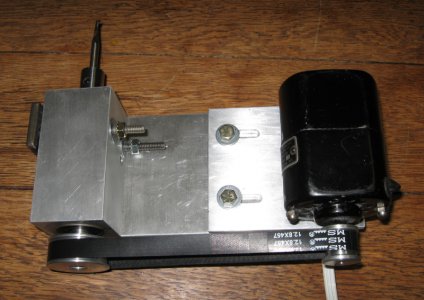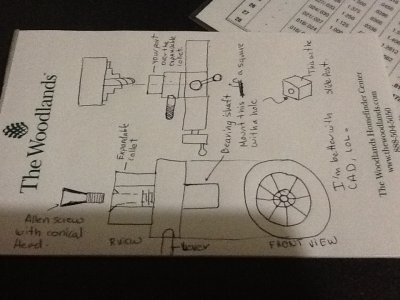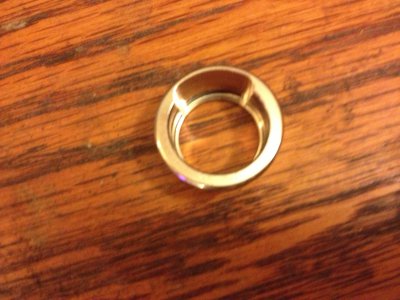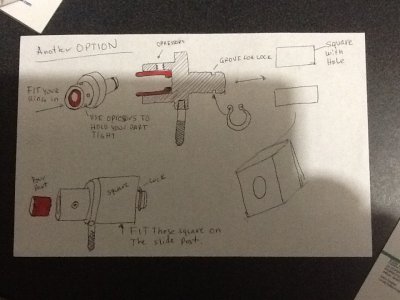Well, I’ve had my LMS 4200 lathe for 8 days now and that isalso the extent of my machining experience. I am trying to make a part with anOD of .805”, an ID of .663”, and a curved notch .60” long x .06 high slopingdown to .055” above the ID. The part is used to hold a reel foot to a fishingrod. The foot fits into the notch. No problem with the basic part but the notchhas me stumped. I know the notch can be done on a mill with a rotary table butcan’t afford one right now. Any suggestions on how to mill a curved notchwithout a mill?
-
Welcome back Guest! Did you know you can mentor other members here at H-M? If not, please check out our Relaunch of Hobby Machinist Mentoring Program!
You are using an out of date browser. It may not display this or other websites correctly.
You should upgrade or use an alternative browser.
You should upgrade or use an alternative browser.
Is it possible to make a curved notch without buying a mill?
- Thread starter jwhealy
- Start date
I'm having trouble picturing your part; any chance you could sketch it up and post a picture?
Are you making those small metal pieces on the rod itself that hold the reel foot to the rod itself? If so, I think you will need at the very least a small milling attachment for the lathe. These usually attach in place of the compound slide.
Are you making those small metal pieces on the rod itself that hold the reel foot to the rod itself? If so, I think you will need at the very least a small milling attachment for the lathe. These usually attach in place of the compound slide.
- Joined
- Jan 22, 2011
- Messages
- 8,031
It would be time consuming but you could drag it in there. Easier if a relief groove is permissible at the blind end for chips to break into.
Or you could rig a die grinder (dremel tool) with a straight carbide burr in the tool post and set up some rotary stops and cut it out.
There are probably other ways too.
Or you could rig a die grinder (dremel tool) with a straight carbide burr in the tool post and set up some rotary stops and cut it out.
There are probably other ways too.
- Joined
- Jan 1, 2013
- Messages
- 185
You could make it in two pieces, a thinwall thimble and a thickwall ring with a section cut out. Soft solder the two together.
Bill
Bill
B
British Steel
Forum Guest
Register Today
Something that works for me on that kind of cut
is a milling cutter held in the 4-jaw, and a rotary table mounted on the cross-slide with a chuck mounted - a 7x12 may limit the size of rotab though, and it's good to have T-slots to bolt down to. Not having a milling machine, I've had to come up with a lot of improvised setups!
As it appears you're cutting brass, you could even get away with a hand-lever to rotate the part in some sort of bearing, using the carriage to put on the depth of cut? Beware the cutter grabbing and pulling the work though, the r/h spiral on the flutes combined with brass's grabby nature can be a recipe for disaster - if you can "sacrifice" an endmill, stone the front cutting edges to zero rake and it'll be much more controllable in brass, not much good in steel, though!
Otherwise, as already suggested, work in the chuck, rotate by hand to stops (even pieces of bar between lathe bed and chuck jaw's in a pinch) and a dremelloid attached to the toolpost, away you go!
Dave H. (the other one)
is a milling cutter held in the 4-jaw, and a rotary table mounted on the cross-slide with a chuck mounted - a 7x12 may limit the size of rotab though, and it's good to have T-slots to bolt down to. Not having a milling machine, I've had to come up with a lot of improvised setups!
As it appears you're cutting brass, you could even get away with a hand-lever to rotate the part in some sort of bearing, using the carriage to put on the depth of cut? Beware the cutter grabbing and pulling the work though, the r/h spiral on the flutes combined with brass's grabby nature can be a recipe for disaster - if you can "sacrifice" an endmill, stone the front cutting edges to zero rake and it'll be much more controllable in brass, not much good in steel, though!
Otherwise, as already suggested, work in the chuck, rotate by hand to stops (even pieces of bar between lathe bed and chuck jaw's in a pinch) and a dremelloid attached to the toolpost, away you go!
Dave H. (the other one)
- Joined
- Apr 6, 2011
- Messages
- 2,082
I was thinking that you could leave the "tube" in the four-jaw chuck, rig up a holder for a broach (or grind a tool out of HSS would be what I would do) in the tail stock, then use the crank/extension of the tail stock to broach the slot. It could probably be done a lot quicker than it sounds  but I would still expect your arm to get a bit tired from cranking.
but I would still expect your arm to get a bit tired from cranking.
-Ron
-Ron
- Joined
- Nov 3, 2012
- Messages
- 97
If this is just for a few pieces, You can build a small end mill on your cross slide, of the lathe. Start with a big block of aluminum, and drill a pair of holes to T nut it to the cross slide. Then use a drill bit in the head stock to drill the bearing hole through the block. that way it is always dead on center. the rest i will post a picture of. I used ball bearings but you could use bronze bushings. For a short run you can dispense with the motor just use a battery drill to turn the end mill. well I will just post a picture for the rest, with some ingenuity you can get it done.



Mount a ball mill on the spindle, a hollow shaft turned to fit the ring you want to machine, mount it on another shaft where it will rotate, all the previous assembly on the post of the slide. You can then precisely locate the slide off center and using a lever to rotate while cutting. If you dont get it, I can make a CAD file for you.





